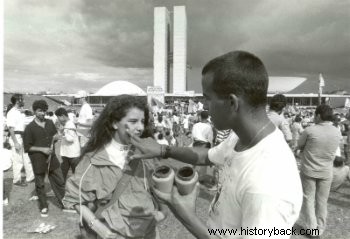The Painted Faces represented a Brazilian student movement that took place in 1992.
It emerged as a response to corruption schemes involving the president of the republic, at the time, Fernando Collor de Mello.
The movement had as its main objective the Impeachment of Collor . It got its name because young people took to the streets with their faces painted in the colors of the country's flag.

Faces painted during demonstration at Planalto Palace (1992)
The demonstrations against the increase in bus fares, which took place in Brazil in July 2013, were called by many “Caras Pintadas 2013” .
Abstract
After the Military Dictatorship in the country, marked by repression, censorship, torture, Brazil elected its 32nd president Fernando Collor de Mello.
At the time, the country was going through crises, above all, due to the hyperinflation that devastated the country, caused by the great instability in the economy.
The population was weakened and the figure of President Fernando Collor, young and popular, made him elected in the direct elections of 1990.
However, the popularity of the young, modern, “honest” and “maharajah hunter” president was debunked. She began to be revealed after her brother's interview for Revista Veja, in May 1992.
This fact exposed the corruption schemes (Esquema Faria) in which President Collor and his treasurer Paulo César Faria were involved.
In view of this, the investigation process began into the actions of the president, accused of embezzling funds, paying personal expenses with checks issued by shell companies.
Thus, a Parliamentary Commission of Inquiry (CPI) was opened in order to investigate the accusations that increasingly tarnished the president's figure. In August 1992, Collor was deposed, having his political rights vetoed.
In this context of popular dissatisfaction, students decided to organize in the early 1990s to depose the president.
It is worth mentioning that students suffered many tortures, deaths and censorship during the period of dictatorship in the country.
They were figures that were centralized in the National Union of Students (UNE) and in the Brazilian Union of Secondary Students (UBES). They have been fighting since the 1980s for democracy, an end to censorship and corruption.
On May 29, 1992, the first organized student meeting took place. The aim was to discuss the country's political situation and agree on what actions would be taken.
During a few days in August 1992, the painted faces movement, which was gaining more and more adherents, represented a landmark protest against political corruption in the country.
With the colors of the national flag plastered on their faces, students and the disaffected population gather in front of the São Paulo Museum of Art on August 11. About 10,000 people were present that day.
Therefore, on August 16, the capitals of Brazil, invaded by marches, gathered many people who represented the country's mourning, wearing black clothes. The act became known as “Black Sunday.”
This was because the day before, Fernando Collor gave a speech about his actions. He proposed that, during the next few days, the Brazilians who were next to him, wear clothes of the national color (green and yellow).
Thus, the result corroborated his figure of criminal and corrupt, in addition to highlighting the general dissatisfaction of the population.
These people took to the streets wearing black in protest, with the central objective of promoting Collor's impeachment.
Read Also :
- Military Dictatorship in Brazil
- Direct Now
- Fernando Collor
- Collor's Impeachment
